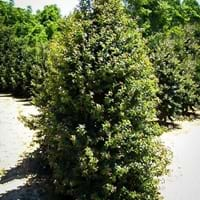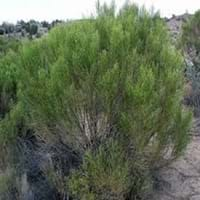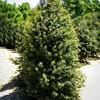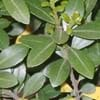Life Span
Perennial
Perennial
Type
Broadleaf Evergreen
Shrub
Origin
Hybrid origin
Hybrid origin, Southwestern United States
Types
Not Available
Not Available
Habitat
Coastal sand dunes, moist forests, Swamps
riparian zones, Semi desert, Upland
USDA Hardiness Zone
6-9
8-10
AHS Heat Zone
Not Available
12-1
Sunset Zone
21,22
7, 8, 9, 10, 11, 12, 13, 14
Habit
Upright/Erect
Spreading
Flower Color Modifier
Bicolor
Not Available
Fruit Color
Red
creamy white
Leaf Color in Spring
Green, Dark Green
Green
Leaf Color in Summer
Dark Green
Green
Leaf Color in Fall
Dark Green
Green
Leaf Color in Winter
Dark Green
Green
Leaf Shape
Oval Spiny Leaves
Oblanceolate , Ovate
Plant Season
Spring, Summer, Fall, Winter
Spring, Summer, Fall, Winter
Sunlight
Full Sun, Partial Sun
Full Sun
Type of Soil
Clay, Loam, Sand
Clay, Loam, Sand
The pH of Soil
Acidic, Neutral
Acidic, Neutral, Alkaline
Soil Drainage
Well drained
Well drained
Bloom Time
Late Spring
Spring
Tolerances
Drought
Drought, Dry soil, Heat Tolerance
Where to Plant?
Ground
Ground, Pot
How to Plant?
Cuttings, Seedlings
Seedlings
Plant Maintenance
Medium
Medium
Watering Requirements
Average Water Needs, Drought Tolerant
Needs very little water
In Summer
Lots of watering
Lots of watering
In Spring
Moderate
Moderate
In Winter
Average Water
Average Water
Soil pH
Acidic, Neutral
Acidic, Neutral, Alkaline
Soil Type
Clay, Loam, Sand
Clay, Loam, Sand
Soil Drainage Capacity
Well drained
Well drained
Sun Exposure
Full Sun, Partial Sun
Full Sun
Pruning
Remove damaged leaves, Remove dead branches, Remove dead leaves
Cut back old stems to the ground, Remove damaged leaves, Remove dead branches, Remove dead leaves
Fertilizers
All-Purpose Liquid Fertilizer
can go long without fertilizers
Pests and Diseases
Red blotch
Pests and diseases free
Plant Tolerance
Drought
Dry Conditions, Dry soil, Heat And Humidity
Flowers
Insignificant
Showy
Flower Petal Number
Single
Single
Foliage Texture
Medium
Fine
Foliage Sheen
Glossy
Glossy
Attracts
Birds
Butterflies
Allergy
Mild Allergen
Unknown
Aesthetic Uses
Landscape Designing
along a porch, deck or patio, Beautification, Ground Cover, Showy Purposes, Wild gardens
Beauty Benefits
Not Available
Not Available
Environmental Uses
Air purification
Air purification
Medicinal Uses
Cold, epilepsy, Itching, Malaria, Pneumonia
anti-inflammatory, Anti-oxidant, cholesterol-lowering
Part of Plant Used
Bark, Fruits, Leaves
Twigs
Other Uses
Decoration Purposes, Used as a dyestuff, Used as Ornamental plant, Used in making tea
Can be made into a herbal tea
Used As Indoor Plant
No
No
Used As Outdoor Plant
Yes
Yes
Garden Design
Feature Plant, Foundation, Hedges, Mixed Border, Screening, Wind Break
Groundcover
Botanical Name
ILEX 'Dragon Lady'
BACCHARIS 'Centennial'
Common Name
Dragon Lady Holly
desert broom , broom baccharis , greasewood
In Hindi
dragon lady holly
desert broom
In German
dragon lady holly
Wüste Besen
In French
dragon lady holly
desert broom
In Spanish
dragon lady holly
escoba del desierto
In Greek
dragon lady holly
desert broom
In Portuguese
dragon lady holly
vassoura do deserto
In Polish
dragon lady holly
desert broom
In Latin
dragon lady holly
desert broom
Phylum
Magnoliophyta
Magnoliophyta
Class
Magnoliopsida
Magnoliopsida
Order
Celastrales
Asterales
Family
Aquifoliaceae
Asteraceae
Clade
Angiosperms, Asterids, Eudicots
Angiosperms, Asterids, Eudicots
Tribe
Not Available
Astereae
Subfamily
Not Available
Not Available
Number of Species
Not Available
Properties of Dragon Lady Holly and Desert Broom
Wondering what are the properties of Dragon Lady Holly and Desert Broom? We provide you with everything About Dragon Lady Holly and Desert Broom. Dragon Lady Holly has thorns and Desert Broom doesn't have thorns. Also Dragon Lady Holly does not have fragrant flowers. Dragon Lady Holly has allergic reactions like Mild Allergen and Desert Broom has allergic reactions like Mild Allergen. Compare all the properties and characteristics of these two plants. Find out which of these plant can be used as indoor plant. If you are interested to decorate your house and garden, find out aesthetic uses, compare them and select the plant which will beautify your surrounding. Along with beautification, try comparing medicinal and edible uses of Dragon Lady Holly and Desert Broom and you can choose the plant having best and most benefits.
Season and Care of Dragon Lady Holly and Desert Broom
Season and care of Dragon Lady Holly and Desert Broom is important to know. While considering everything about Dragon Lady Holly and Desert Broom Care, growing season is an essential factor. Dragon Lady Holly season is Spring, Summer, Fall and Winter and Desert Broom season is Spring, Summer, Fall and Winter. The type of soil for Dragon Lady Holly is Clay, Loam, Sand and for Desert Broom is Clay, Loam, Sand while the PH of soil for Dragon Lady Holly is Acidic, Neutral and for Desert Broom is Acidic, Neutral, Alkaline.
Dragon Lady Holly and Desert Broom Physical Information
Dragon Lady Holly and Desert Broom physical information is very important for comparison. Dragon Lady Holly height is 460.00 cm and width 180.00 cm whereas Desert Broom height is 60.00 cm and width 150.00 cm. The color specification of Dragon Lady Holly and Desert Broom are as follows:
Dragon Lady Holly flower color: White
Dragon Lady Holly leaf color: Green and Dark Green
Desert Broom flower color: White
- Desert Broom leaf color: Green
Care of Dragon Lady Holly and Desert Broom
Care of Dragon Lady Holly and Desert Broom include pruning, fertilizers, watering etc. Dragon Lady Holly pruning is done Remove damaged leaves, Remove dead branches and Remove dead leaves and Desert Broom pruning is done Cut back old stems to the ground, Remove damaged leaves, Remove dead branches and Remove dead leaves. In summer Dragon Lady Holly needs Lots of watering and in winter, it needs Average Water. Whereas, in summer Desert Broom needs Lots of watering and in winter, it needs Average Water.





